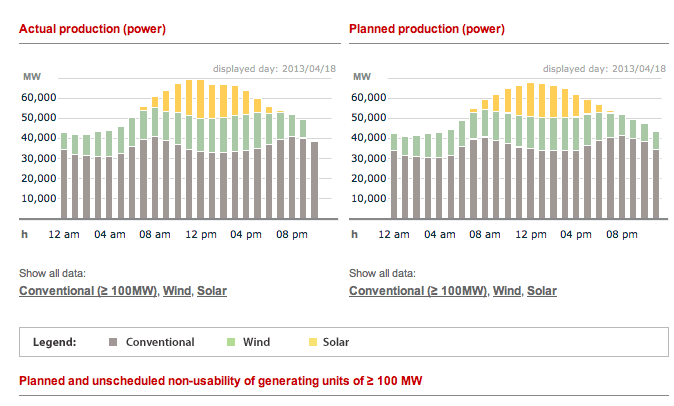Today’s graph of the graph is a follow-up to Wednesday’s graph of the day, which highlighted the fact that Germany set a new record for solar output of 22.6GW on Monday.
On Thursday, it did not set a new solar record, but in combination with consistent output of wind energy, renewable generation reached record capacity of 36GW, and for three hours between noon and 3pm exceeded the combined contribution of coal, gas and nuclear plants.
This is the graph below. A couple of interesting points – one is the consistent output of wind throughout the day, the second is the comparison with what was planned by the energy market operator. It matches almost perfectly, which goes to show that renewables can be intermittent, but they are predictable – which is the vital piece of information for an energy market operator. If you got to the original graphic, it will allow you to hover over the bars to get more detailed information of the output from each energy source.
Given the huge output of solar PV, it will be interesting to see what happens to this graph when battery storage is introduced. Germany, which was the first country to introduce feed in tariffs on solar, the principal reason why it has the world’s biggest solar PV capacity at more than 32GW, is about to introduce the first subsidy for energy storage systems, which can smooth the output of PV, and push it into the evening peaks.
PV Magazine reports the energy storage subsidy will begin on May 1, with the bank KfW providing cheap finance, and a 30 per cent rebate being offered on the battery system by Germany’s Federal Environment Ministry. The energy storage system is meant to be used in tandem with distributed solar installations with storage systems developed in Germany; the funds come with a maximum size requirement of 30 kilowatts.
The batteries must have a warranty of at least seven years to gain the subsidy. Another requirement is that the PV installation sends 60 percent of its capacity to the grid over the lifetime of the plant. As the magazine wonders, “could a German subsidy on energy storage replicate the German solar miracle for batteries instead? We should find out in a few weeks.”









